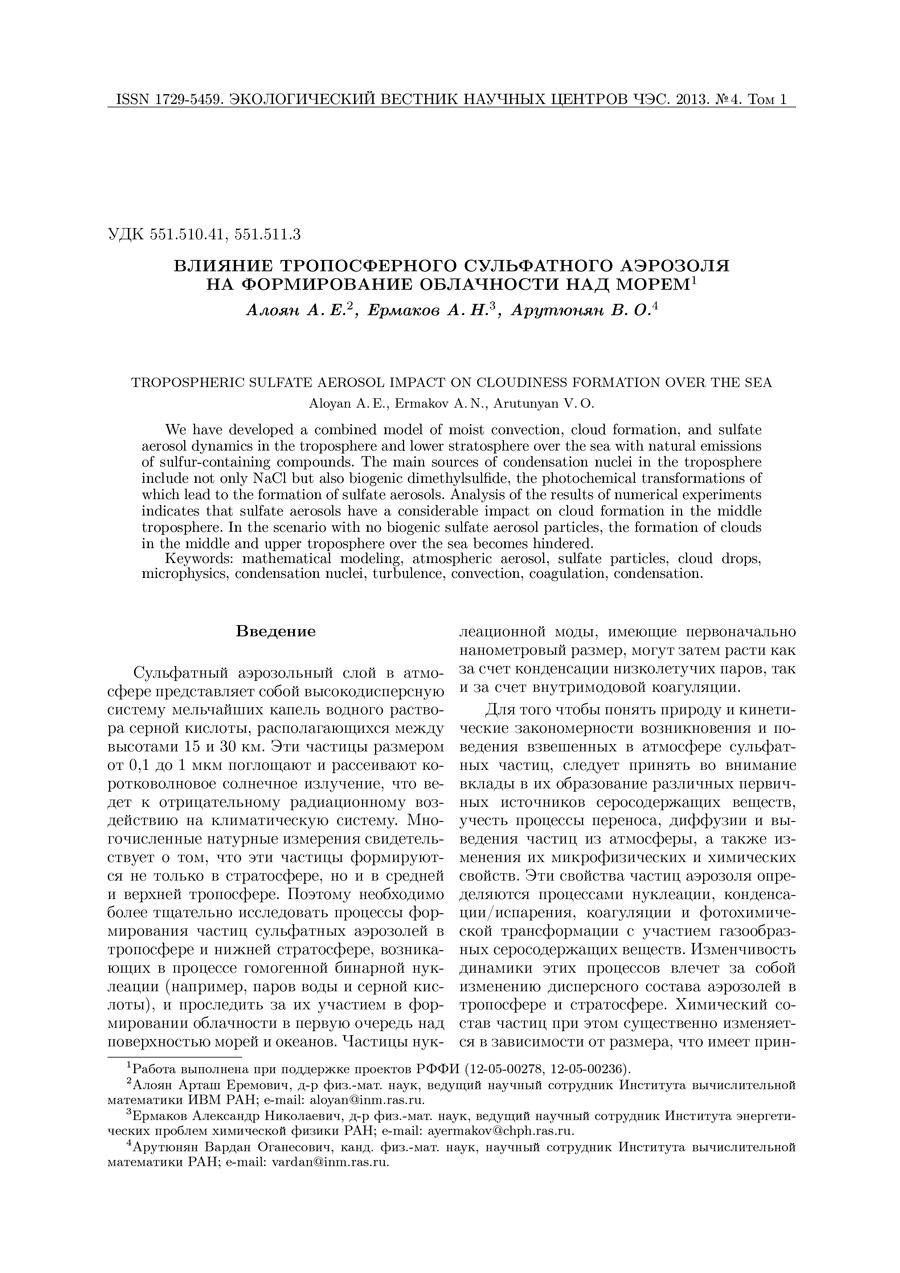Tropospheric sulfate aerosol impact on cloudiness formation over the sea
UDC
551.510.41, 551.511.3Abstract
We have developed a combined model of moist convection, cloud formation, and sulfate aerosol dynamics in the troposphere and lower stratosphere over the sea with natural emissions of sulfur-containing compounds. The main sources of condensation nuclei in the troposphere include not only NaCl but also biogenic dimethylsulfide, the photochemical transformations of which lead to the formation of sulfate aerosols. Analysis of the results of numerical experiments indicates that sulfate aerosols have a considerable impact on cloud formation in the middle troposphere. In the scenario with no biogenic sulfate aerosol particles, the formation of clouds in the middle and upper troposphere over the sea becomes hindered.
Keywords:
mathematical modeling, atmospheric aerosol, sulfate particles, cloud drops, microphysics, condensation nuclei, turbulence, convection, coagulation, condensationAcknowledgement
References
- Aloyan A.E. Mathematical modeling of the interaction of gas species and aerosols in atmospheric dispersive systems // Russ. J. Num. Anal. Math. Model. 2000. Vol. 15. No. 1-4. P. 211-224.
- Алоян А.Е., Ермаков А.Н., Арутюнян В.О. Формирование сульфатных аэрозолей в тропосфере и нижней стратосфере // Исследование возможной стабилизации климата с помощью новых технологий. Проблемы адаптации к изменению климата. М.: Росгидромет, 2012. С. 75-98.
- Алоян А.Е., Арутюнян В.О. Моделирование динамики аэрозолей и формирования облачности при лесных пожарах // Экологический вестник научных центров Черноморского экономического сотрудничества. 2008. №3. C. 1-15.
- Gal-Chen T., Somerville R.C.J. On the use of a coordinate transformation for the solution of the Navier-Stokes equations // J. Comput. Phys. 1975. Vol. 17. P. 209-228.
- Pruppacher H.R., Klett, J.D. Microphysics of clouds and precipitation. Dordrecht.: Reidel, 1978. 714 p.
- Kogan Y.L. The simulation of a convective cloud in a 3-D model with explicit microphysics. Part I: Model description and sensitivity experiments // J. Atmos. Sci. 1991. Vol. 48. No. 9. P. 1160-1189.
- Марчук Г.И. Методы вычислительной математики. Москва.: Наука, 1980. 456 с.
- Алоян А.Е. Моделирование динамики и кинетики газовых примесей и аэрозолей в атмосфере. Москва.: Наука, 2008. 201 с.
- Алоян А.Е., Ермаков А.Н., Арутюнян В.О. Моделирование конвективной облачности и ее влияние на газовый состав атмосферы // Изв. РАН: Физика атмосферы и океана. 2010. Т. 46. №6. С. 1-15.
- Aloyan A.E. Mathematical modeling of convective cloudiness with phase transitions // Russ. J. Num. Analys. Math. Modeling. 2010. No. 6. C. 1-12.
Downloads
Issue
Pages
Submitted
Published
How to Cite
Copyright (c) 2013 Aloyan A.E., Ermakov A.N., Arutunyan V.O.

This work is licensed under a Creative Commons Attribution 4.0 International License.




